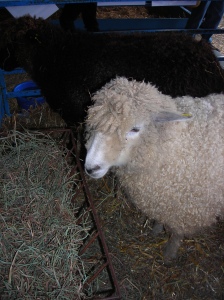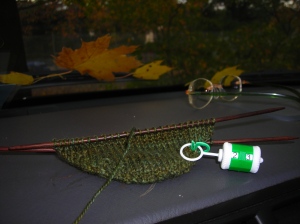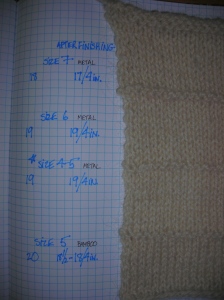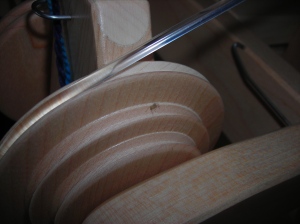We were sure that this was going to be a soaking wet cold weekend from beginning to end. But if it ever poured, it must have been when we were indoors, taking classes or petting the sheep, goats, alpacas and llamas, or chatting with the farmers or roaming the aisles filled with vendors with more goodies for sale than I could have ever imagined. This was my first NYS Sheep and Wool Festival and I was not to be disappointed.

FRIDAY
We arrived early Friday for a class with Annie Modesitt called Cable Mania. She taught us how to design and work several different cables without using a cable needle. This class was right up my alley because I can be pretty klutzy and usually spend considerable time either looking for a misplaced needle or picking up the one I’ve dropped. Combine this with having to manipulate multiple double-pointed needles and what should be relaxing quickly becomes juggling 101. Annie is a great entertainer and educator. She has a unique teaching style that made it easy for me to memorize how to make the stitches quickly. I’ve been wanting to make a pair of socks for my BF, and now I’m confident enough to design them with cables too. We’ll be taking Annie’s Increase and Decrease class on Sunday morning.
Before we left the festival on Friday, we watched the vendors loading in and setting up. It was then I realized that even though I loved to shop, at this event I might just drop first.
Susie had made arrangements for a group of her ravelry fans to stay at a rented house near the fairgrounds. Her farm is Juniper Moon Farm, fiberfarm.com. It is the 1st CSA (community supported agriculture) that is fiber based. Previously the farm name was Martha’s Vineyard Fiber Farm / Hudson Valley Fiber Farm. Her new logo is tres-cool and we can’t wait to see new products that feature it. We had a blast eating, imbibing and chatting with many people I’d only met online. We love Susie and her yarn. I received my Spring 2009 Share in the mail last week. I planned to check out what other fair-goers were wearing for pattern inspiration. At the party, a fellow shareholder was already knitting the mohair-cormo blend and it looked beautiful.
SATURDAY
We were back at the Fairgrounds early Saturday and barely out of the parking lot when we heard the shepherd’s whistle. The dog trials were in full swing. We watched in awe as the sheepdog listened to the commands and moved the sheep around the fields and gates and into the pen. We decided that we wanted to see more animals and headed to the barns.
Sheep had long ago won a special place in my heart but my friend was more partial to the goats. We chatted with owners of many different breeds and also learned about the featured breed, Leicester Longwool.  The cool thing about this breed is their historic significance. They were developed in the late 18th century by Robert Bakewell. His work with breeding animals influenced great men like Charles Darwin and Gregor Mendel. George Washington was also interested in his ideas and Leicester Longwools grazed at Mount Vernon. Other breeds such as the Border Leicester, Coopworth and Corriedate were created from Leicester stock. In the 1920’s or 1930’s the breed died out in the U.S. When the Colonial Williamsburg Foundation wanted a historic breed for the historic area, they choose the Leicester Longwool. The Foundation started a flock in 1990 with animals they imported from Tasmania and continue to help this breed survive in the U.S. today.
The cool thing about this breed is their historic significance. They were developed in the late 18th century by Robert Bakewell. His work with breeding animals influenced great men like Charles Darwin and Gregor Mendel. George Washington was also interested in his ideas and Leicester Longwools grazed at Mount Vernon. Other breeds such as the Border Leicester, Coopworth and Corriedate were created from Leicester stock. In the 1920’s or 1930’s the breed died out in the U.S. When the Colonial Williamsburg Foundation wanted a historic breed for the historic area, they choose the Leicester Longwool. The Foundation started a flock in 1990 with animals they imported from Tasmania and continue to help this breed survive in the U.S. today.
As a new spinner, I want to learn about different fibers that are available for spinning . I decided that Leiscester Longwool would be the perfect souvenir for this event and made a mental note to buy some before I went home. It will be interesting to play with fiber from some of the closely related breeds at some future date to see what the similarities and differences there may be. Or maybe this is the start of a new tradition. The NYS Sheep and Wool website has posted the 2010 featured breed as Amerrican Oxford.
We went to the sheep auction. My friend wondered if the auctioneer was speaking the same language as us or if he had developed an abbreviated version. I overheard this conversation fragment, ” If it has four legs, I can’t bring it home .” I am sorry to say that I can’t bring it home because I live in Brooklyn and we are currently not zoned for livestock. Is there hope for me?
But there was lots I could bring home and, after taking Annie’s class, finding the perfect sock yarn for my BF was high on my list. I chose Blue Ridge Yarns Footprints – a superwash merinos multi-color yarn that comes packed with a 100 yd. skein in a coordinating color. I plan to use the more solid olive green for the toes. I’ll knit the socks from the toe up and I can’t wait to cast on. We oggled and stroked an alphabet of exotic fibers from alpaca, buffalo, camel to yak.
One of the highlights of the afternoon was listening to Linda Ligon, founder of Interweave Press, speak about how the fiber world has changed since she started her company more than 30 years ago. At one time, I had 20 years of Handwoven on my bookshelf and am a big fan. She is one of America’s leading authorities on the evolution of the domestic fiber industry. She said that the interest in knitting over the past six years has contributed to a resurgence in interest in spinning and weaving. I’m thinking that because knitting is so accessible it may very well be the gateway drug to fiber addiction! She was asked why she thought so many people seemed to prefer synthetic fibers to natural fibers. A self proclaimed fiber snob, she said that synthetic fibers have a place in the world too and keep people in the Guatemalan Highlands warm, and bring smile to children’s faces when they receive brightly colored sweaters to wear. There is a place in the world for synthetics too.
We were on our way out of the fair around closing time when we realized that the artichoke line was no longer LONG. So. we snagged a french style one and we recommend it heartily. It was just the right amount of snack to give us the energy to continue on to the Ravelry party.
And boy, does Ravelry know how to throw a party. The heated tents were packed with ravelers. If the number of ravelers attending the party Saturday night was any indication of the health of fiber craft in New York, then it is in great shape.
Thanks to ravelry.com for a terrific party and all the vendors who provided prizes and goodies for the guests.
Sssh, don’t tell BB that we had fun meeting Bob. 
SUNDAY
We were late again for class on Sunday, but soon settled in to learn what Annie Modesitt would teach us in the Increase and Decreases class. She provided clear instructions, and demonstrated with style and theatrical flair. We knit and practiced in order to reinforce the newly learned material. But even if we hadn’t, her hand-out perfectly reiterated what we learned in class, so there would be no chance that we wouldn’t be able to duplicate the stitches in the future. I felt privileged to be in her class. I am a quirky continental knitter, and it has suited me fine because it was fast. I’d developed my own strategies for interpreting stitch directions and relied on what I could see in order to knit a stitch “open” instead of twisted. Before I met Annie, I’d wondered if I’d be instructed to knit differently. As it turns out – I could not have been farther from the truth. She was non-judgemental and worked with me and I don’t think I knit so strangely anymore. I am glad I’ve stick to my guns, because she taught me that there is no wrong way to knit. I can’t wait for time to read her book “Confessions of a Knitting Heretic” .
After class, we visited more animals. Did you know that llamas and alpacas are the same genus – lama, with one L? We couldn’t seem to leave the alpaca and llama barn. The owners of Creekside Acres Fiberfarm in Pleasant Valley and Dakota Ridge Farm in Ballston Spa were especially generous with information. My friend and I are still trying to decide if we had to chose between lamas , which we ‘d want to own. She is leaning towards the llamas and I am leaning towards the alpacas. One owner likened their personality to that of cats – they are independant and smart, gentle and curious at the same time. They are also so very very soft and have the most amazing ears. I was near to tears when one of the ladies, brought two of her alpacas out on the halter for a walk. They have a beautiful gait and are so elegant and dear. On our third trip back into the barn for more communing with the animals, we bought fiber. I got some gorgeous black alpaca roving to spin. It will be a way to remember the experiences of the day and is a small way to support the small farms.  Without which Rhinebeck would not be what it is today.
Without which Rhinebeck would not be what it is today.




 I started asking questions last week and am again floored by what I don’t know and what I should consider. Consider this: different manfacturers’ knitting needles, label ed the same size, are not created equal. I discovered this when diligently swatching a new yarn. How could it possibly be that a size 4 needle and a size 6 needle give virtually the same number of stitches per inch? After much frustration, I got out my trusty needle gauge and discovered the nasty truth. This is one more reason why we need to swatch! You just can’t trust that going up or down a size will get the result you anticipated.
I started asking questions last week and am again floored by what I don’t know and what I should consider. Consider this: different manfacturers’ knitting needles, label ed the same size, are not created equal. I discovered this when diligently swatching a new yarn. How could it possibly be that a size 4 needle and a size 6 needle give virtually the same number of stitches per inch? After much frustration, I got out my trusty needle gauge and discovered the nasty truth. This is one more reason why we need to swatch! You just can’t trust that going up or down a size will get the result you anticipated.  I finished my first pair of socks and was asked to make another pair. How hard could it be to add cables, I thought. And make them a bit bigger? Use a different yarn?
I finished my first pair of socks and was asked to make another pair. How hard could it be to add cables, I thought. And make them a bit bigger? Use a different yarn?
 The cool thing about this breed is their historic significance. They were developed in the late 18th century by Robert Bakewell. His work with breeding animals influenced great men like Charles Darwin and Gregor Mendel. George Washington was also interested in his ideas and Leicester Longwools grazed at Mount Vernon. Other breeds such as the Border Leicester, Coopworth and Corriedate were created from Leicester stock. In the 1920’s or 1930’s the breed died out in the U.S. When the Colonial Williamsburg Foundation wanted a historic breed for the historic area, they choose the Leicester Longwool. The Foundation started a flock in 1990 with animals they imported from Tasmania and continue to help this breed survive in the U.S. today.
The cool thing about this breed is their historic significance. They were developed in the late 18th century by Robert Bakewell. His work with breeding animals influenced great men like Charles Darwin and Gregor Mendel. George Washington was also interested in his ideas and Leicester Longwools grazed at Mount Vernon. Other breeds such as the Border Leicester, Coopworth and Corriedate were created from Leicester stock. In the 1920’s or 1930’s the breed died out in the U.S. When the Colonial Williamsburg Foundation wanted a historic breed for the historic area, they choose the Leicester Longwool. The Foundation started a flock in 1990 with animals they imported from Tasmania and continue to help this breed survive in the U.S. today.
 Without which Rhinebeck would not be what it is today.
Without which Rhinebeck would not be what it is today.
